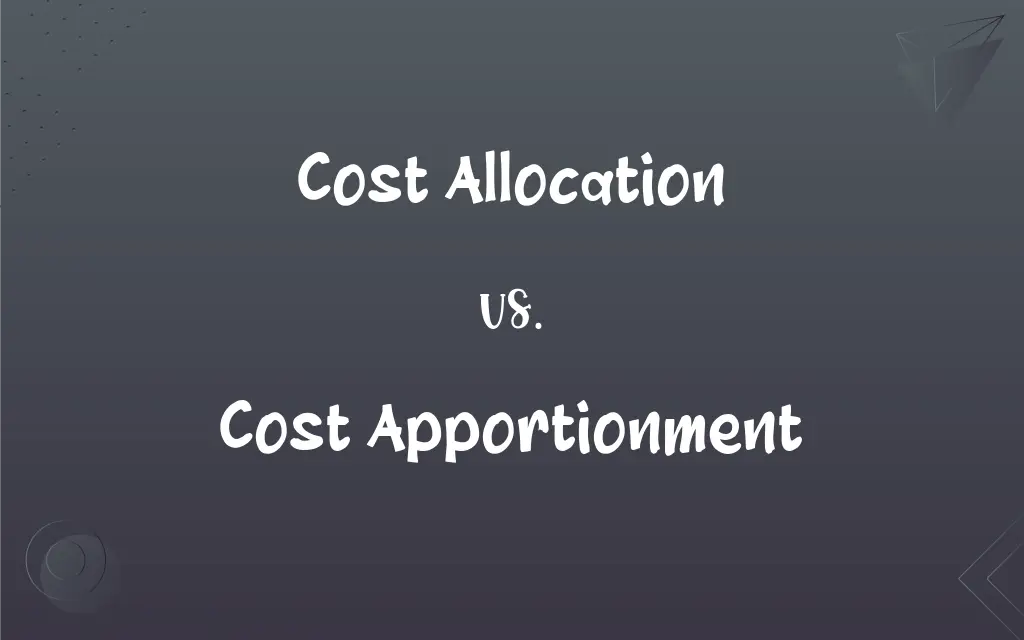Cost Allocation vs. Cost Apportionment: What's the Difference?
Edited by Aimie Carlson || By Harlon Moss || Published on November 23, 2023
Cost allocation is the process of assigning specific costs to particular cost centers or objects, while cost apportionment involves dividing aggregate costs among different departments or units based on a predetermined formula.

Key Differences
Cost allocation directly assigns costs to specific cost objects, such as projects, departments, or products, based on a direct relationship. Cost apportionment, on the other hand, involves the distribution of costs that cannot be directly assigned, such as overhead costs, across multiple departments or projects based on a fair and reasonable basis.
In cost allocation, the focus is on tracing costs accurately to the cost object, ensuring that the costs are directly related to that object. Cost apportionment, however, deals with the division of shared or indirect costs, like utilities or rent, among different cost centers or departments, often using a basis like floor space or headcount.
Cost allocation is typically more straightforward, as it involves costs that can be easily and specifically identified with a cost object. Cost apportionment requires a methodological approach to distribute costs fairly among various recipients, which may not have a direct link to the costs.
The purpose of cost allocation is to provide precise cost data for specific cost objects, aiding in accurate pricing, budgeting, and profitability analysis. Cost apportionment is essential for understanding the share of indirect costs borne by different segments of an organization, aiding in cost control and internal chargebacks.
Cost allocation and cost apportionment are integral parts of cost accounting, with allocation focusing on direct cost assignment and apportionment on equitable distribution of indirect costs across various departments or projects.
ADVERTISEMENT
Comparison Chart
Type of Costs Involved
Direct costs that can be specifically assigned.
Indirect costs that need to be divided among departments.
Assignment Method
Directly assigned to a specific cost object.
Distributed based on a predetermined formula or basis.
Focus
Accuracy in tracing costs to cost objects.
Fair distribution of shared costs.
Purpose
Precise cost information for pricing and budgeting.
Understanding the share of indirect costs in departments.
Application
Used in specific, identifiable scenarios.
Applied when costs cannot be directly linked to cost objects.
ADVERTISEMENT
Cost Allocation and Cost Apportionment Definitions
Cost Allocation
Assigning specific costs to distinct cost objects.
The cost allocation for the new project included direct labor and material costs.
Cost Apportionment
Distribution of common costs to multiple cost centers.
Cost apportionment ensures that each project contributes fairly to shared resource expenses.
Cost Allocation
Process of identifying and assigning costs to specific activities or products.
Accurate cost allocation is crucial for determining the profitability of each product line.
Cost Apportionment
Allocation of overhead costs based on a predetermined formula.
The company uses employee headcount for cost apportionment of utilities.
Cost Allocation
Distribution of direct costs to relevant cost centers.
The company's cost allocation process ensures that each department bears its fair share of direct expenses.
Cost Apportionment
Method of splitting indirect expenses among various segments.
The cost apportionment of administrative salaries is done according to departmental revenues.
Cost Allocation
Attribution of costs to the areas where they are incurred.
Cost allocation for the marketing campaign was based on the specific activities undertaken.
Cost Apportionment
Dividing shared or indirect costs among different departments.
Cost apportionment of the office rent is based on the floor area occupied by each department.
Cost Allocation
Direct linking of costs to operations or projects.
The new software aided in the precise cost allocation for various ongoing projects.
Cost Apportionment
Equitable division of costs that cannot be directly assigned.
The cost apportionment for company-wide software licenses is based on user count in each department.
FAQs
What is cost allocation?
It's the process of assigning specific costs directly to cost objects like projects or products.
Can cost allocation be used for budgeting?
Yes, it helps in creating precise budgets by allocating costs to relevant cost centers.
What types of costs are involved in cost apportionment?
Indirect costs like rent, utilities, and administrative expenses are typically involved.
Is cost allocation used for pricing?
Yes, it helps determine the cost of products or services for accurate pricing.
Why is cost allocation important?
It provides accurate cost data for specific objects, aiding in decision-making and financial analysis.
What basis is used for cost apportionment?
Bases like floor space, headcount, or usage are commonly used.
Is cost allocation relevant for all types of businesses?
Yes, businesses of all sizes and types use cost allocation for financial management.
Does cost apportionment require a standard method?
While there's no one-size-fits-all method, the chosen basis should be fair and reasonable.
Can cost apportionment be subjective?
The choice of apportionment basis can introduce subjectivity, though efforts are made to keep it as objective as possible.
How does cost apportionment aid in cost control?
By understanding the distribution of indirect costs, departments can manage and control their expenses better.
Are there any challenges in cost allocation?
Accurately tracing and assigning specific costs can sometimes be challenging.
How does cost apportionment differ from cost allocation?
Cost apportionment involves dividing shared or indirect costs among different departments, unlike direct assignment in cost allocation.
How frequently should cost apportionment be reviewed?
Regular reviews are necessary to ensure continued fairness and relevance of the chosen basis.
How is cost allocation used in profitability analysis?
It helps determine the profitability of different cost objects by assigning direct costs.
How does cost apportionment impact departmental budgets?
It influences how much each department is charged for shared resources, affecting their budgets.
Does cost allocation involve overhead costs?
Generally, it focuses on direct costs, with overheads often handled by cost apportionment.
Is cost apportionment important for tax purposes?
It can be, especially in allocating costs for tax deductions and understanding the tax liabilities of different departments.
Can cost allocation be automated?
Modern accounting software can automate much of the cost allocation process.
Can cost allocation affect financial reporting?
Yes, it impacts how costs are reported and analyzed in financial statements.
What is a common challenge in cost apportionment?
Determining the most equitable basis for distributing indirect costs can be complex.
About Author
Written by
Harlon MossHarlon is a seasoned quality moderator and accomplished content writer for Difference Wiki. An alumnus of the prestigious University of California, he earned his degree in Computer Science. Leveraging his academic background, Harlon brings a meticulous and informed perspective to his work, ensuring content accuracy and excellence.
Edited by
Aimie CarlsonAimie Carlson, holding a master's degree in English literature, is a fervent English language enthusiast. She lends her writing talents to Difference Wiki, a prominent website that specializes in comparisons, offering readers insightful analyses that both captivate and inform.






































































